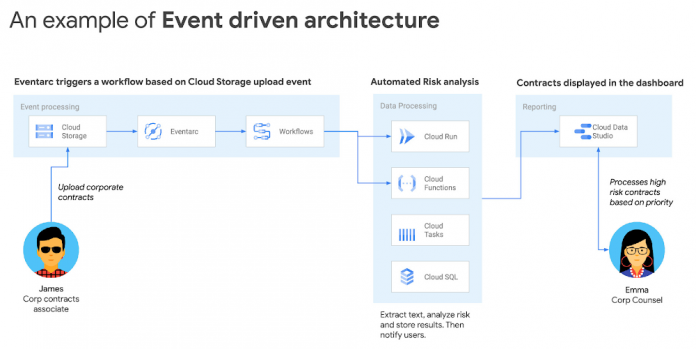Harnessing the power of data is key to the success of organizations. However, what it means to be data-driven changes as the nature of business and user expectations also change. In today’s fast-paced landscape, organizations need to immediately react to data. Users expect action using up-to-date, real-time data and insights. Building applications and systems that react quickly provides the real-time insights that users expect, and that organizations depend on.
At Google Cloud, our serverless products empower developers to rapidly build applications that react to events without ever managing a server. While working with customers on their journey to the cloud, we’ve witnessed some of the world’s largest organizations rapidly create business critical-applications by effortlessly connecting multiple services, driving business insights at high velocity. We call this use of serverless products to deliver data insights the programmable cloud.
The ability to easily connect services enables developers to deliver applications that drive business value. Rather than hiring developers to maintain servers, our customers’ developers ship products and features that help them stay ahead of the competition. Developers at L’Oréal use Google Cloud’s serverless compute and analytics tools to deliver customized and inclusive beauty experiences to their consumers. Likewise, developers at Shopify use Google Cloud to improve scalability and velocity for merchants, and developers at IKEA personalize shopping experiences.
The complexity and sophistication of our customers’ use cases grows as they extend their cloud workloads. We’ve noticed increasing demand for connecting different applications and services with less code. Independent of industry, customers leverage serverless architectures to connect and extend the cloud across Google Cloud services, third-party services and their own custom services. Here are some common use cases:
Data-processing pipelines that run transformation asynchronously or inline. Example: a home security camera captures images that are processed to detect deliveries and thefts. Cloud Functions then feeds the new data to Vertex AI in order to update models and make them more accurate.
Real-time analytics on files streamed from Cloud Storage into BigQuery using Cloud Functions. Example: Security threat analysis on incoming logs that draws insights and highlights malicious behavior.
Change Data Capture (CDC) to detect and capture data changes for processing in downstream systems. Example: Send CDC events from Firestore to a cloud function to take actions like notifying users or update a data warehouse.
Cloud Ops automation to programmatically augment infrastructure lifecycle operations when provisioning and modifying cloud resources. Example: Create customized notifications when a Compute Engine VM is created or shut down.
Business process automation workflows for reliable and traceable execution of business workflows. Example: Take action before a quota or billing threshold is reached by automatically adjusting resources, or execute an e-commerce order end-to-end, from payment processing and warehouse inventory checks to delivery notices.
When integrating services, it’s all too easy to introduce tight coupling, which grows brittle, slow and difficult to debug over time. Cloud Functions, Eventarc, Workflows, Tasks and Scheduler allow you to integrate services in a manner that is inherently asynchronous and loosely coupled, preserving the agility of each individual service, while still allowing rapid innovation. What’s more, existing applications running in Google Cloud can be simply and flexibly extended with Cloud Functions.
There are two types of integration patterns enabling the Programmable Cloud:
1. Synchronous extensions powered by Cloud Functions augment existing functionality of other GCP services. For example, developers can use:
Cloud Functions as part of a BigQuery SQL query with new Remote User Defined Functions (UDFs) that integrate data analysis and reporting with complex procedural code and business logic.
Custom blocking code from Cloud Functions when users create accounts or sign in to applications through Identity Platform.
2. Asynchronous event-driven patterns powered by Eventarc, Workflows, Tasks and Scheduler make it possible to respond to triggers or events (i.e., when this happens, then do that). For example, developers can set up Eventarc to trigger Workflows on events that are then reliably processed by a combination of Google Cloud, third-party, and custom services.
We are excited by the opportunities that lie ahead as we empower organizations to move to the Cloud easily with serverless technologies from Google Cloud. In our recent Easy as Pie – Serverless Hackathon, more than 1500 developers from around the world conceived of and built 97 solutions in just 10 weeks, demonstrating how easy it is to get a solution to market with Google Cloud. Most importantly, the serverless technologies help foster a Low Ops vision, opening up solutions to developers who don’t need to know how to set up or manage infrastructure. A programmable cloud is transformational — it enables organizations to leapfrog from a data-driven to an event-driven culture that focuses on high value business problems. Get started on your transformation today.
Cloud BlogRead More


